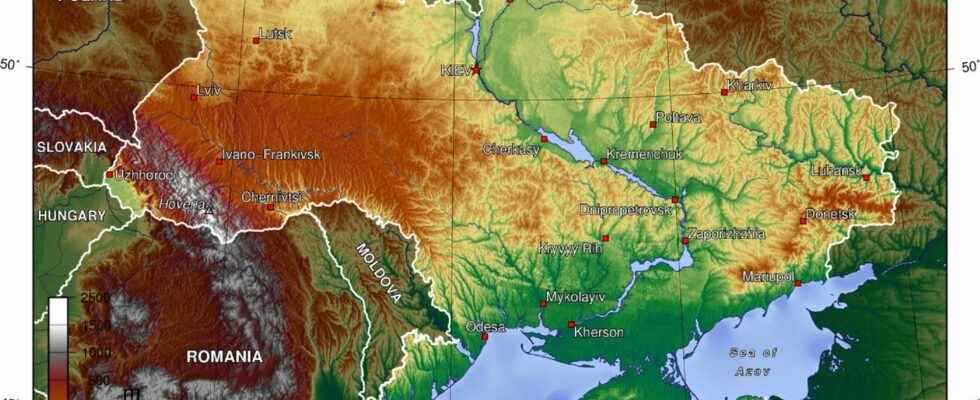You will also be interested
Strategic position between the eastern and western parts of the European continent, bordering the Black Sea, the Ukrainian territory has seen various populations with very different cultures settle on its soil, and this, from Antiquity and more particularly during the first centuries. of our era.
From Slavic tribes to Kievan Rus’
It is thus successively populated by the Goths, then by Turkic or Finno-Ugric peoples (Huns, Avars, Bulgarians, Khazars, Magyars, Tatars, Mongols…), which settle mainly along the Black Sea. The western, central and northern parts are rather occupied by Slavic tribes, and this, since the VIand century. The city of Kiev, one of the oldest in Eastern Europe, was thus founded by the Scandinavian peoples. It was then certainly a trading post ideally located on the road linking Scandinavia to Constantinople.
In the VIIIand century, the Varangians, eastern vikings, federated these different Slavic tribes through trade, until Kiev was taken by Oleg the Wise, who then founded the Rus’ (or Rous) of Kiev. This principality is the first outline of modern Russia which owes its name to it. Until the XIand century, it is also the largest state in Europe. Little by little, the population, then under Varangian influence, converted for the most part to Christianity. This is the principality’s golden age. But this period of prosperity will however be followed by a dark age. In 1240, Kiev was completely destroyed by the Mongols who invaded and settled in the territory. It will lose all influence for several centuries and will be subject to the successive control of its more powerful neighbors.
Polish and Lithuanian domination, birth of the Cossack people
The Mongol invasion was fiercely resisted by the Poles and the Lithuanians, who ended up recovering the northwestern part of the territory of present-day Ukraine. Kiev was thus annexed in 1362 to the Grand Duchy of Lithuania. The Tatar people continue to be present on the Black Sea coast as well as in Crimea.
Gradually, the Kingdom of Poland extended its influence over the entire Ukrainian territory, while leaving the current Belarusian territory to the Grand Duchy of Lithuania. The Duchy of Ruthene occupies Kiev and the southeastern part of the territory.
The mainly Lithuanian-Polish domination of the XVand century, which imposes Catholicism, leads to an uprising of Orthodox peasants who regroup under the effigy of the Cossack people. Then gradually emerges an important cleavage cultural between the north-western part, Orthodox and under Lithuanian-Polish influence and the south-eastern part, under Turkish-Tatar domination but which will later come under the control of the Russian Empire. This divide is still visible today and is now illustrated by a pro-European tendency in the northwest, and a pro-Russian tendency in the southeast.
In the XVIand century, the Cossacks rose up against the Polish nobility. Kiev then regains an important position, notably as a cultural center, with the aim of unifying the Cossack and Ruthenian peoples. This series of uprisings shakes the foundations of the Lithuanian-Polish union which then controls the Cossack territory and leads around 1650 to the birth of an autonomous Cossack territory which takes the name of “Ukraine”, whose etymology refers to a “border country”. This embryo of present-day Ukraine then extends into the basin of the Dnieper, between Poland and Russia. At the beginning of the XVIIIand century, Cossack Ukraine is a highly literate and cultured country.
Annexation by the Russian Empire and first independence in 1917
But, from 1709, the Cossacks were annexed by the Russian Empire. The south of the territory is still under Tatar and Ottoman control. Following the expansion of the Russian Empire towards Poland, all the borders of the region were redrawn: in 1772, Galicia (Western Ukraine) became Austrian and in 1793, Austriaautonomy of the Cossacks is suppressed. Three-quarters of present-day Ukraine thus came under Russian domination, and were divided into several vassal administrative entities, such as the governments of Kiev, Chernigov, Ekaterinoslav…
These different “governments” are grouped into several entities, such as Little Russia (which represents the majority of the current territory of Ukraine) and New Russia located along the Black Sea. The Ukrainian language was banned in schools in 1876 to stem the return of a regionalist movement. But Russia will not be able to silence the nationalist who wins the country. In 1917, when the Russian Empire was weakened by the First World War and the russian revolution, the Ukrainians thus declare their independence. This action resulted in the creation of the Central Rada, a representative body located in Kiev and of which Mykhaïlo Hrushevsky became the first president.
The situation is however far from being stabilized and Ukraine will have to face, during the XXand century, to numerous coups and clashes with its Polish, Russian or German neighbours. In a few decades, the territory of Ukraine was torn and fragmented, to end up under Soviet control. The road to unification and construction of modern Ukraine would not end until 1954, with the transfer of Crimea to the Soviet Socialist Republic (RSS) of Ukraine by Khrushchev. Then it will be necessary to wait for the fall of the Soviet Union so that Ukraine regains its independence, proclaimed on August 24, 1991.
And yet, the country’s story is far from over. She plays herself still today.
Interested in what you just read?
